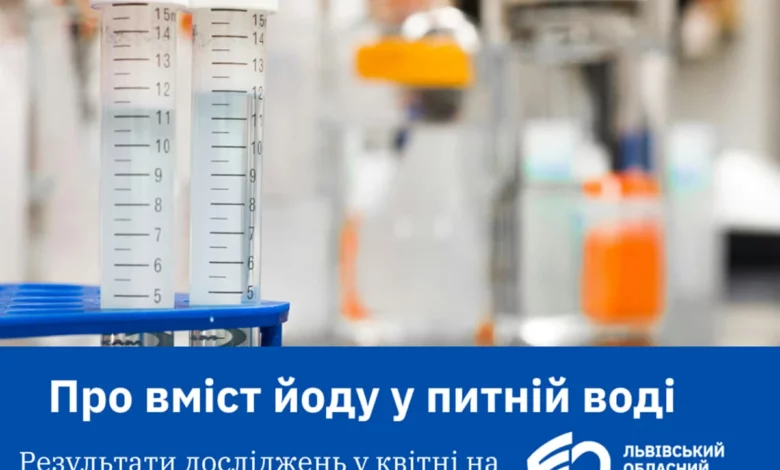
According to the test results, deviations were found in 22 samples from 24 regions of the region.
According to the Lviv Regional Laboratory Center for Disease Control and Prevention of the Ministry of Health of Ukraine, in April, laboratory tests of drinking water for iodine content were conducted. Thus, 24 samples were examined. Deviations in iodine content in drinking water were found in 22 samples, which is 92%. According to the State Sanitary Norms and Regulations “Hygienic Requirements for Drinking Water Intended for Consumption людиною” (DSanPiN 2.2.4-171-10), the deviation ranges from 14.3-19.7 µg/dm3, while the norm is 20-30 µg/dm3.
Iodine deficiency in the body leads to stunted growth in children, metabolism, impaired intellectual activity and development. The daily requirement for iodine in the human body, depending on age, ranges from 90 to 300 mcg. For women, this rate is 150-300 mcg, and for men – up to 300 mcg. For children aged 0-6 years – 90 mcg, from 6 to 12 years – 120 mcg.
“Since iodine is not synthesized in the human body, this trace element must be consumed daily. It is necessary to compensate for the lack of iodine with the help of food products of plant and animal origin, which are rich in this microelement: iodized salt, seaweed, sea fish, squid, flounder, shrimp. Iodine is also found in potatoes, pork, beef, cereals, vegetables, and fruits,” the Lviv Regional Center for Disease Control and Prevention said.
In particular, a reduced iodine content in drinking water was found in the following territorial communities:
- Zhovkva (Zhovkva – 16.9 µg/dm3, Dobrotvir – 16.0 µg/dm3, Kamianka Buzka – 16.7 µg/dm3);
- Chervonohradska (Uhniv – 18.8 µg/dm3, Sosnivka – 18.8 µg/dm3, Belz – 19.8 µg/dm3, Huta village – 15.9 µg/dm3, Sokal – 18.5 µg/dm3, Chervonohrad – 19.7 µg/dm3);
- Radekhivska (Radekhiv city – 18.1 µg/dm3, Lopatyn village – 17.8 µg/dm3, Vuzlove village – 17.2 µg/dm3, Stoyaniv village – 17.0 µg/dm3);
- Lviv (Lviv: Dovha, 1 Dovha St. – 18.6 µg/dm3, Sokilnyky, 121 Stryiska St. – 15.8 µg/dm3, Kryvchytsi, 117a Hlynianskyi Trakt – 17.2 µg/dm3, Pivnichna-35, 9 Mykolaychuk St. – 15.3 µg/dm3, Yanivska, 89 Shevchenka St. 89, 14.3 µg/dm3, Budzen, 1 Zbyralna St., 17.2 µg/dm3, Sykhiv, 28 Sonyashnykova St., 18.7 µg/dm3, Ryasne, 3 Velichkovskoho St., 15.4 µg/dm3, Vynnyky, 4 Proektna St., 19.7 µg/dm3).
In accordance with the Regional Action Plan for the Prevention of Iodine Deficiency among the Population of Lviv Region for 2023-2025, approved by the Order of the Head of the Lviv Regional Military Administration of 30.12.2022 No. 825/0/5-22VA, the Plan for Monitoring Studies of Environmental Objects, Human Hazards and the Environment of Lviv Region for 2024, approved by the Order of the Head of the Lviv Regional Military Administration of 19.01.2024 No. 64/0/5-24VA, laboratory studies were planned for 2024.

